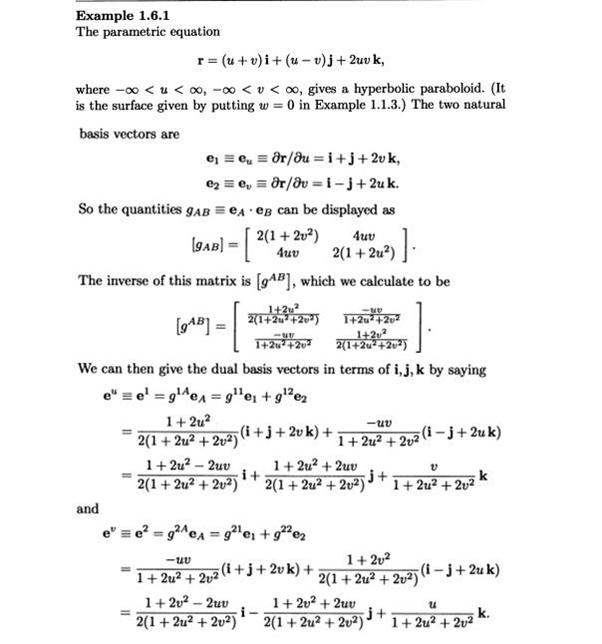Answered step by step
Verified Expert Solution
Question
1 Approved Answer
Example 1.6.1 The parametric equation r= (u+v)i + (u-v)j + 2uv k, where -0 < u < 00, -0 < < o, gives a


Example 1.6.1 The parametric equation r= (u+v)i + (u-v)j + 2uv k, where -0 < u < 00, -0 < < o, gives a hyperbolic paraboloid. (It is the surface given by putting w = 0 in Example 1.1.3.) The two natural basis vectors are e = e, So the quantities 9AB A g can be displayed as [9AB] = [2 ]. The inverse of this matrix is [AB], which we calculate to be 1+2 2(1+2u+20) [AB] = [ 1+2u+20 and r/du=i+j+2vk, dr/Ov=i-j+2uk. 2(1+20) We can then give the dual basis vectors in terms of i, j, k by saying e"=e=ge=ge+ge -EV 1+2u+2u2 4uv 4uv 2(1+2u) 1+2u 2(1+2u+2v) (i+j+ 2vk) + 1+2u-2uv 2(1+2u+20) 2(1+2u+2v)+ i+ 1+2v - 2uv 2(1 +2u + 2v) e" = e=g^cA=ge +92e 1+2 2(1+2u+20) -UV 2v k) + 1 + 2u + 2v (i j + 2uk) 1+2u +2uv (i+j+2vk) + V 1+2u+2v k 1+2v 2(1+2u+2u2) 1+ 2v +2uv 2(1+2u+20) + j(i j + 2uk) k. u 1+2u+2v Problems 2 1. Obtain the geodesic equations (using arc-length s as a parameter) for the hyperbolic paraboloid of Example 1.6.1. Deduce that all parametric curves are geodesics.
Step by Step Solution
★★★★★
3.43 Rating (156 Votes )
There are 3 Steps involved in it
Step: 1

Get Instant Access to Expert-Tailored Solutions
See step-by-step solutions with expert insights and AI powered tools for academic success
Step: 2

Step: 3

Ace Your Homework with AI
Get the answers you need in no time with our AI-driven, step-by-step assistance
Get Started


